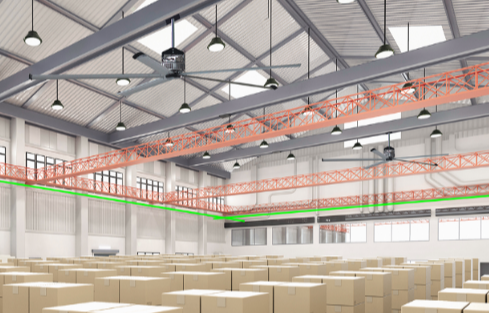Why Every Warehouse Should Consider HVLS Fans for Optimal Airflow

High Volume Low Speed (HVLS) fans have become a vital component in modern warehouse management due to their ability to create optimal airflow. These fans, with diameters ranging from 7 to 24 feet, are designed to move large volumes of air at low speeds, making them ideal for large, open spaces like warehouses. Here are several compelling reasons why every warehouse should consider installing HVLS fans for optimal airflow:
Enhanced Air Circulation
Efficient Air Movement
HVLS fans are engineered to move significant amounts of air gently and consistently throughout a large space. Unlike traditional high-speed fans that create turbulent airflow, HVLS fans produce a steady breeze that can cover a wide area. This efficient air movement helps to eliminate hot and cold spots within the warehouse, ensuring a uniform temperature and comfortable environment for workers.
Temperature Regulation
Warehouses often experience temperature stratification, where hot air rises to the ceiling, and cooler air remains at the floor level. This can lead to uneven temperatures and increased energy consumption as heating or cooling systems work harder to maintain a comfortable environment. HVLS fans help to destratify the air, distributing heat evenly during winter and creating a cooling effect during summer by enhancing air circulation. This results in more consistent indoor temperatures and improved energy efficiency.
Improved Worker Comfort and Productivity
Reducing Heat Stress
During hot weather, warehouses can become uncomfortably warm, leading to heat stress among workers. Heat stress can cause fatigue, decreased concentration, and even serious health issues like heat stroke. Fans for warehouses create a cooling effect through the wind chill phenomenon, which can reduce the effective temperature by several degrees. By lowering the ambient temperature and increasing comfort, HVLS fans help to prevent heat stress and maintain worker productivity.
Enhancing Air Quality
Good air quality is essential for the health and well-being of warehouse employees. Poor ventilation can lead to the accumulation of dust, fumes, and other airborne contaminants. HVLS fans improve air circulation, which helps to disperse pollutants and bring in fresh air from outside. This reduces the concentration of harmful particles and improves overall indoor air quality, contributing to a healthier work environment.
Read more Sustainable and Ethical Saree Shopping Online
Energy Efficiency and Cost Savings
Reducing HVAC Load
HVLS fans work in tandem with existing HVAC systems to enhance their efficiency. By promoting even temperature distribution and reducing the need for constant heating or cooling, HVLS fans can lower the workload on HVAC systems. This synergy leads to significant energy savings and reduced utility bills. In large warehouses, the cost savings from improved energy efficiency can be substantial over time.
Lower Maintenance Costs
HVLS fans are designed for durability and require minimal maintenance compared to traditional high-speed fans. Their robust construction and low-speed operation mean less wear and tear, reducing the frequency and cost of repairs. This reliability makes HVLS fans a cost-effective investment for maintaining optimal airflow and comfort in a warehouse setting.
Enhancing Safety
Reducing Slip and Fall Hazards
Slip and fall accidents are common in warehouses, often caused by wet or slippery floors. HVLS fans help to mitigate this risk by promoting faster drying of spills or condensation on floors. The consistent airflow generated by these fans enhances the evaporation of moisture, reducing the likelihood of slip hazards and contributing to a safer work environment.
Fire Hazard Mitigation
Dust accumulation and poor ventilation can contribute to fire hazards in warehouses. Dust particles are highly flammable, and poor air circulation can allow combustible fumes to build up. HVLS fans help to disperse dust and improve ventilation, reducing the concentration of flammable materials in the air. This proactive approach to air management helps to lower the risk of fire incidents, enhancing overall safety in the warehouse.
Versatility and Adaptability
Suitable for Various Applications
HVLS fans are incredibly versatile and can be used in a wide range of warehouse applications. Whether it’s a large distribution center, a manufacturing facility, or a storage warehouse, HVLS fans can be adapted to meet the specific airflow needs of the space. Their large coverage area and ability to provide consistent airflow make them suitable for virtually any warehouse environment.
Customizable Settings
Modern HVLS fans come with variable speed controls and programmable settings, allowing warehouse managers to customize their operation based on seasonal requirements and specific needs. For instance, fans can be set to run at higher speeds during peak summer months for maximum cooling or at lower speeds during winter to assist with heat distribution. This flexibility ensures that the fans provide optimal airflow year-round.
Environmental Benefits
Reducing Carbon Footprint
By enhancing the efficiency of HVAC systems and reducing overall energy consumption, HVLS fans help to lower the carbon footprint of warehouses. This is an important consideration for businesses aiming to adopt more sustainable practices. The energy savings achieved through the use of HVLS fans contribute to a reduction in greenhouse gas emissions, supporting environmental sustainability initiatives.
Supporting Green Building Standards
Many modern warehouses aim to meet green building standards such as LEED (Leadership in Energy and Environmental Design). HVLS fans contribute to these standards by improving energy efficiency, enhancing indoor air quality, and supporting sustainable building operations. Installing HVLS fans can help warehouses earn points towards green building certifications, showcasing their commitment to environmental responsibility.
Conclusion
HVLS fans offer numerous benefits that make them an essential consideration for every warehouse. Their ability to enhance air circulation, regulate temperature, improve air quality, and increase energy efficiency contributes to a more comfortable, productive, and safe working environment. Additionally, the cost savings from reduced HVAC load and lower maintenance expenses make HVLS fans a wise investment. By adopting HVLS fans, warehouses can optimize airflow, enhance worker well-being, and support sustainable operations, making them a crucial component of modern warehouse management.






